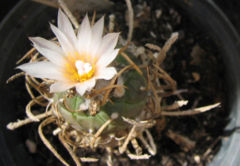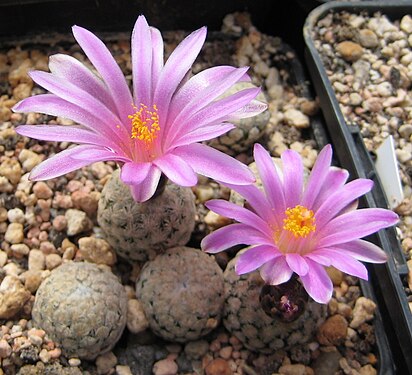Difference between revisions of "Turbinicarpus"
(Created page with '{{SPlantbox |familia=Cactaceae |genus=Turbinicarpus |Temp Metric=°F |jumpin=If this plant info box on watering; zones; height; etc. is mostly empty you can click on the edit tab…') |
|||
| Line 2: | Line 2: | ||
|familia=Cactaceae | |familia=Cactaceae | ||
|genus=Turbinicarpus | |genus=Turbinicarpus | ||
| + | |habit=cacti-succulent | ||
| + | |lifespan=perennial | ||
| + | |exposure=sun | ||
| + | |water=dry | ||
| + | |features=flowers | ||
|Temp Metric=°F | |Temp Metric=°F | ||
| − | + | |image=Turbinicarpus.jpg | |
| − | |image= | ||
|image_width=240 | |image_width=240 | ||
}} | }} | ||
| − | + | '''''Turbinicarpus''''' is a [[genus]] of very small to medium-sized [[cactus|cacti]], which inhabit the north-eastern regions of [[Mexico]], in particular the states of [[San Luis Potosí]], [[Guanajuato]], [[Nuevo León]], [[Querétaro]], [[Hidalgo (state)|Hidalgo]], [[Coahuila]], [[Tamaulipas]] and [[Zacatecas]]. | |
| + | |||
| + | These succulent plants grow mostly on limestone soil (never on volcanic soil), at altitudes between 300 and 3300 meters above sea level. | ||
| + | |||
| + | ''Turbinicarpus'' are usually confined to specific habitats, generally hostile for the majority of plants, mostly in very drained rocky areas, composed of limestone, sandstone, schist (neutral or alkaline), or in very acidic and humiferous underwood, or in gypsum veins, sometimes so pure that is almost white. | ||
| + | |||
| + | In particular, ''Turbinicarpus strictu sensu'' are adapted to extreme niches: more than 80% of the species grow in rock cracks or among the pebbles beneath them, where enough dust accumulated to enable root development. It would seem almost impossible that plants so small could survive in such an environment, however in those species that inhabit dry and exposed areas, the root is very thick, becoming a taproot and acting like an anchor on the slopes but, more important, as a water storage for the dry periods, capable of significantly retracting into the ground so that the stem is less exposed to the sun; the spines are often changed to adopt a very papery structure, capable of absorbing good quantities of water. Furthermore, the general look is extremely mimetic, thanks to the epidermis colour and the interlacing spines, guaranteeing a certain protection from eventual herbivores. | ||
==Cultivation== | ==Cultivation== | ||
| Line 18: | Line 28: | ||
| − | == | + | ==Species== |
| + | ===Genus ''Turbinicarpus''=== | ||
| + | ==== Subgenus ''Turbinicarpus'' ==== | ||
| + | ===== Serie ''Gracilis'' ===== | ||
| + | *''Turbinicarpus dickisoniae'' | ||
| + | *''Turbinicarpus gracilis'' | ||
| + | *''[[Turbinicarpus hoferi]]'' | ||
| + | *''[[Turbinicarpus swobodae]]'' | ||
| + | |||
| + | ===== Serie ''Lophophoroides'' ===== | ||
| + | *''[[Turbinicarpus alonsoi]]'' | ||
| + | *''[[Turbinicarpus bonatzii]]'' | ||
| + | *''Turbinicarpus flaviflorus'' | ||
| + | *''[[Turbinicarpus knuthianus]]'' | ||
| + | *''[[Turbinicarpus jauernigii]]'' | ||
| + | *''[[Turbinicarpus laui]]'' | ||
| + | *''[[Turbinicarpus lophophoroides]]'' | ||
| + | *''[[Turbinicarpus rioverdensis]]'' | ||
| + | |||
| + | ===== Serie ''Macrochele'' ===== | ||
| + | *''Turbinicarpus macrochele'' | ||
| + | *''Turbinicarpus macrochele subsp. frailensis'' | ||
| + | *''Turbinicarpus macrochele subsp. polaskii'' | ||
| + | *''Turbinicarpus macrochele subsp. valteri'' | ||
| + | |||
| + | ===== Serie ''Turbinicarpus'' ===== | ||
| + | *''Turbinicarpus klinkerianus'' | ||
| + | *''Turbinicarpus klinkerianus subsp. schwartzii'' | ||
| + | *''Turbinicarpus klinkerianus subsp. hiemalis'' | ||
| + | *''Turbinicarpus klinkerianus subsp. planiziei'' | ||
| + | *''[[Turbinicarpus schmiedickeanus]]'' | ||
| + | *''Turbinicarpus schmiedickeanus subsp. rubriflorus'' | ||
| + | *''Turbinicarpus schmiedickeanus subsp. andersonii'' | ||
| + | |||
| + | ===== Serie ''Valdeziani'' ===== | ||
| + | * ''[[Turbinicarpus pseudopectinatus]]'' | ||
| + | * ''[[Turbinicarpus valdezianus]]'' | ||
| + | |||
| + | ===== Serie ''Gymnocactus'' ===== | ||
| + | * ''[[Turbinicarpus nieblae]]'' | ||
| + | * ''[[Turbinicarpus saueri]]'' subsp. ''saueri'' | ||
| + | * ''Turbinicarpus saueri'' subsp. ''nelissae'' | ||
| + | * ''[[Turbinicarpus ysabelae]]'' | ||
| + | |||
| + | ===== Serie ''Viereckii'' ===== | ||
| + | * ''[[Turbinicarpus gielsdorfianus]]'' | ||
| + | * ''[[Turbinicarpus major]]'' | ||
| + | * ''[[Turbinicarpus viereckii]]'' subsp. ''viereckii'' | ||
| + | * ''Turbinicarpus viereckii'' subsp. ''neglectus'' | ||
| + | |||
| + | ===== natural hybrids ===== | ||
| + | *''Turbinicarpus × mombergeri'' (''pseudopectinatus × laui'') | ||
| + | |||
| + | ==== Subgenus ''Kadenicarpus'' ==== | ||
| + | ===== Section ''Bravocactus'' ===== | ||
| + | *''[[Turbinicarpus horripilus]]'' | ||
| + | |||
| + | ===== Section ''Kadenicarpus'' ===== | ||
| + | *''Turbinicarpus krainzianus'' | ||
| + | *''Turbinicarpus krainzianus subsp. minimus'' | ||
| + | *''[[Turbinicarpus pseudomacrochele]]'' | ||
| + | |||
| + | ===Genus ''Rapicactus''=== | ||
| + | ==== Subgenus ''Rapicactus'' ==== | ||
| + | *''[[Rapicactus beguinii]]'' | ||
| + | *''Rapicactus beguinii subsp. hintoniorum'' | ||
| + | *''[[Rapicactus booleanus]]'' | ||
| + | *''Rapicactus canescens'' | ||
| + | *''Rapicactus donatii'' | ||
| + | *''[[Rapicactus subterraneus]]'' | ||
| + | *''[[Rapicactus zaragosae]]'' | ||
| + | |||
| + | ==== Subgenus ''Lodia'' ==== | ||
| + | *''[[Rapicactus mandragora]]'' | ||
| + | *''[[Rapicactus pailanus]]'' | ||
| + | ===Synonymy=== | ||
| + | The following genera haven been brought into synonymy with ''Turbinicarpus'': | ||
| + | *''[[Gymnocactus]]'' <small>[[Backeb.]]</small> | ||
| + | *''[[Normanbokea]]'' <small>[[Kladiwa]] & [[Buxb.]]</small> | ||
==Gallery== | ==Gallery== | ||
<gallery perrow=5> | <gallery perrow=5> | ||
| − | + | File:Gymnocactus horripilus 1.jpg | |
| − | + | File:Turbinicarpus swobodae.jpg | |
| − | Image:Upload.png| photo | + | File:Turbinicarpus valdezianus03.jpg |
| + | File:Turbinicarpus alonsoi.jpg | ||
| + | Image:Upload.png| photo | ||
</gallery> | </gallery> | ||
Latest revision as of 13:26, 5 May 2010
| Habit | cacti-succulent
| |
|---|---|---|
| Lifespan: | ⌛ | perennial |
| Exposure: | ☼ | sun |
|---|---|---|
| Water: | ◍ | dry |
| Features: | ✓ | flowers |
Turbinicarpus is a genus of very small to medium-sized cacti, which inhabit the north-eastern regions of Mexico, in particular the states of San Luis Potosí, Guanajuato, Nuevo León, Querétaro, Hidalgo, Coahuila, Tamaulipas and Zacatecas.
These succulent plants grow mostly on limestone soil (never on volcanic soil), at altitudes between 300 and 3300 meters above sea level.
Turbinicarpus are usually confined to specific habitats, generally hostile for the majority of plants, mostly in very drained rocky areas, composed of limestone, sandstone, schist (neutral or alkaline), or in very acidic and humiferous underwood, or in gypsum veins, sometimes so pure that is almost white.
In particular, Turbinicarpus strictu sensu are adapted to extreme niches: more than 80% of the species grow in rock cracks or among the pebbles beneath them, where enough dust accumulated to enable root development. It would seem almost impossible that plants so small could survive in such an environment, however in those species that inhabit dry and exposed areas, the root is very thick, becoming a taproot and acting like an anchor on the slopes but, more important, as a water storage for the dry periods, capable of significantly retracting into the ground so that the stem is less exposed to the sun; the spines are often changed to adopt a very papery structure, capable of absorbing good quantities of water. Furthermore, the general look is extremely mimetic, thanks to the epidermis colour and the interlacing spines, guaranteeing a certain protection from eventual herbivores.
Cultivation
Propagation
Pests and diseases
Species
Genus Turbinicarpus
Subgenus Turbinicarpus
Serie Gracilis
- Turbinicarpus dickisoniae
- Turbinicarpus gracilis
- Turbinicarpus hoferi
- Turbinicarpus swobodae
Serie Lophophoroides
- Turbinicarpus alonsoi
- Turbinicarpus bonatzii
- Turbinicarpus flaviflorus
- Turbinicarpus knuthianus
- Turbinicarpus jauernigii
- Turbinicarpus laui
- Turbinicarpus lophophoroides
- Turbinicarpus rioverdensis
Serie Macrochele
- Turbinicarpus macrochele
- Turbinicarpus macrochele subsp. frailensis
- Turbinicarpus macrochele subsp. polaskii
- Turbinicarpus macrochele subsp. valteri
Serie Turbinicarpus
- Turbinicarpus klinkerianus
- Turbinicarpus klinkerianus subsp. schwartzii
- Turbinicarpus klinkerianus subsp. hiemalis
- Turbinicarpus klinkerianus subsp. planiziei
- Turbinicarpus schmiedickeanus
- Turbinicarpus schmiedickeanus subsp. rubriflorus
- Turbinicarpus schmiedickeanus subsp. andersonii
Serie Valdeziani
Serie Gymnocactus
- Turbinicarpus nieblae
- Turbinicarpus saueri subsp. saueri
- Turbinicarpus saueri subsp. nelissae
- Turbinicarpus ysabelae
Serie Viereckii
- Turbinicarpus gielsdorfianus
- Turbinicarpus major
- Turbinicarpus viereckii subsp. viereckii
- Turbinicarpus viereckii subsp. neglectus
natural hybrids
- Turbinicarpus × mombergeri (pseudopectinatus × laui)
Subgenus Kadenicarpus
Section Bravocactus
Section Kadenicarpus
- Turbinicarpus krainzianus
- Turbinicarpus krainzianus subsp. minimus
- Turbinicarpus pseudomacrochele
Genus Rapicactus
Subgenus Rapicactus
- Rapicactus beguinii
- Rapicactus beguinii subsp. hintoniorum
- Rapicactus booleanus
- Rapicactus canescens
- Rapicactus donatii
- Rapicactus subterraneus
- Rapicactus zaragosae
Subgenus Lodia
Synonymy
The following genera haven been brought into synonymy with Turbinicarpus:
Gallery
References
External links
- w:Turbinicarpus. Some of the material on this page may be from Wikipedia, under the Creative Commons license.
- Turbinicarpus QR Code (Size 50, 100, 200, 500)





